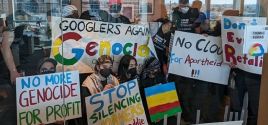Surveillance society keeps an eye outBy Sheldon AlbertsThe Ottawa Citizen Sep. 03, 2006 |
Popular 
Report: Blinken Sitting On Staff Recommendations to Sanction Israeli Military Units Linked to Killings or Rapes

America Last: House Bill Provides $26B for Israel, $61B for Ukraine and Zero to Secure U.S. Border

'Woke' Google Fires 28 Employees Who Protested Gaza Genocide

Bari Weiss' Free Speech Martyr Uri Berliner Wants FBI and Police to Spy on Pro-Palestine Activists

John Hagee Cheers Israel-Iran Battle as 'Gog and Magog War,' Will Lobby Congress Not to Deescalate
 When vandals embarked recently on an evening of random mischief, toppling soda machines in communities up and down Maryland's Eastern Shore, this tiny farming village was the only place they left untouched. Police Chief Merl Evans believes he knows why -- the surveillance cameras. The town of Ridgely, population 1,600, has six, all paid for with counter-terrorism funding from the U.S. Department of Homeland Security. For more than a year, the cameras have recorded every moment of life along Central Avenue, Ridgely's one-block, no-stoplight commercial district, giving police a visual record of anyone who bought groceries at Tri-Me Warehouse Foods, picked up a prescription at Ridgely Pharmacy, or stopped for pizza at Sam's Restaurant. There are cameras on the town's water tower and water treatment centre, both deemed to be potential terror targets, and even a camera hidden inside the pavilion at a park frequented on weekend evenings by teens. "They work real well as a deterrent," says Chief Evans, 59, police chief here since 2003. "The main street here was never touched because they know we have got cameras." In the five years since the Sept. 11, 2001, terror attacks, the installation of surveillance cameras by police forces has exploded across the United States as authorities scrambled to improve security measures. The proliferation has been justified, primarily, as a way to help law enforcement agencies detect potential terrorist activity in locations that cannot be constantly patrolled. According to one estimate, by the consulting firm Frost & Sullivan, surveillance cameras will be a $4-billion industry by 2010 in the U.S. The rapid expansion of video surveillance has also triggered a national debate among privacy advocates who fear the U.S. is on the verge of becoming a surveillance society, with government and police employing Orwellian tactics in the name of the war on terror. "9/11 has provided a great excuse to spend money in this area, but I don't think many people believe that the surveillance cameras are going to detect terrorist acts," says Marc Rotenberg, executive director of the Electronic Privacy Information Centre, a Washington-based group that tracks government surveillance activities in the U.S. "These surveillance networks tend to cover broad parts of the city -- rather than say just having a camera outside an ATM or in a convenience store parking lot -- so there really is a legitimate concern about a Big Brother surveillance society." Homeland Security budgeted $2 billion for grants to state and local governments in 2006 to strengthen counter-terrorism efforts. While the department does not specify how much money went to surveillance equipment, dozens of U.S. cities have won funding by deeming cameras essential for "target hardening" of critical infrastructure. The New York Police Department earlier this year announced an $81.5-million plan earlier to place 500 surveillance cameras in a "ring of steel" around Lower and Midtown Manhattan to monitor suspicious activity. In Chicago, police can monitor 2,250 cameras in an ever-expanding "homeland security grid." City officials are using part of a $5.1-million Homeland Security grant to install new high-definition, motion-sensitive cameras designed to send alerts when people linger outside public buildings or leave packages unattended. In Washington, D.C., city council recently approved plans to install 23 surveillance cameras in residential communities. Police in Virginia Beach, Virginia, are testing surveillance systems equipped with facial-recognition technology. But the surveillance cameras have proven most popular in communities not typically considered high on the list of potential targets. A recent survey by Scripps Howard News Service found more than 200 towns and cities, in 37 states, now use video cameras for general surveillance, such as monitoring sidewalks, parks, schools and other community facilities. From his second-floor office just off Central Avenue, Chief Evans can monitor pedestrian and vehicular traffic that, even on busy days, might best be described as sporadic. He is the first to acknowledge that Ridgely, a farming community surrounded in summer by towering fields of corn, is not likely the sort of place terrorists would strike, but there are locations here, he says, that might tempt criminals -- such as fertilizer and diesel fuel depots that hold the basic ingredients of homemade explosives. Critics say the use of surveillance cameras for counter-terrorism is both a waste of Homeland Security money and a threat to the privacy of Americans. "Surveillance cameras have no proven track record in preventing or deterring terrorism. There are just no known cases where they have been used to that effect," says Jeffrey Rosen, a professor of law at George Washington University and author of The Unwanted Gaze: The Destruction of Privacy in America. "Their proliferation has been driven by fear. 9/11 naturally created fear, which created a desire for a technological solution," Mr. Rosen says. "Cameras are very popular with the public as a whole, mostly because they make people feel safer." The same push for surveillance swept Great Britain in the 1980s and 1990s as law enforcement sought ways to combat regular IRA bombings. The city of London has more than 200,000 surveillance cameras, says Mr. Rosen, but none prevented the subway bombings of 2005. The cameras "did help determine the identity of the suicide bombers and aided the police in subsequent investigations," says EPIC's Mr. Rotenberg, "but obviously they had no deterrent effect in preventing the act, because suicide bombers are not particularly concerned about being caught in the act. Cameras are not an effective way to stop a person that is prepared to commit that kind of act." Police in cities such as Chicago and Baltimore, however, argue surveillance cameras have helped drive crime level downs to historic lows. In New York, police say crime in the Bronx has dropped 30 per cent in areas where cameras have been installed. But even where they aid criminal investigations, Mr. Rosen says they are of little use in terror investigations because the U.S. lacks a data base that could match the faces of suspected terrorists against images captured by cameras. Even the most significant surveillance technologies, which use facial-recognition software, confuse men for women and can be tricked by anyone who puts on a disguise, Mr. Rosen says. "Cameras are considered a prestige item. They are relatively cheap because you don't have to spend much money manning them and people like to feel cutting edge and high tech," Mr. Rosen says. "But it is a foolish diversion of resources from the stuff that actually works, like communication and information-sharing and intelligence-sharing on the ground." Following 9/11, a bipartisan group of U.S. civil libertarians and libertarian conservatives was able to beat back the most ambitious surveillance proposals, including one in Washington that would have linked cameras on government buildings, transit systems and residential neighbourhoods into a vast network. "The week after 9/11, I imagined America would be wired up as ubiquitously as Britain," says Mr. Rosen. "That didn't happen, because of a political culture here which is strongly suspicious of government and (was) willing to fight the proliferation of these badly designed technologies." But Mr. Rosen believes the U.S. is on a slippery slope toward becoming a surveillance society. "There are very serious concerns about privacy in an age when it is possible in theory to use cameras and, through ubiquitous surveillance, reconstruct all of the movements a person makes over the course of an entire day," Mr. Rosen says. "This is not science fiction." |



